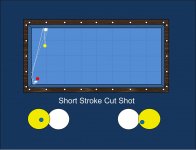Of course it matters...
If you want a basic explanation:
Impulse is the integral of force with respect to time from the 'initial' time to 'final' time. Conceptually, it is the change in momentum. Thus if the tip is in contact with the for a longer time, the more impulse (change in momentum) is created. In a long stroke, the tip is in contact for a longer time. Think of it as pushing the ball...
When a ball is at rest, the forces acting on it are gravity and the normal force from the table. When the cue strikes the ball, we have added the force from the cue and the friction acting against the motion of the ball. The longer we apply this force, the more time is it accelerating.
As for the spin of the ball, think about torque. A most basic example is the wrench example. When using a wrench to turn a screw it is much easier to turn it when holding it at the end the the wrench, away from the jaw. This is how english works. The farther your cue is from the "center of mass" the more english. Mathematically, Torque = force x radius, with the force being perpendicular to the wrench at the point of its application.
Torque vector = (radius vector * force vector * sine theta) * normal vector To find the magnitude of torque, we just don't multiply by the normal vector. Angular acceleration for a rotating object is proportional to the net torque applied.
Thus the greater the radius (from the center of the ball and assuming the same force), the greater the torque. The more force, the more spin as well.
And more directly concerning long/short stroke, work = force * distance. It is directly proportional... the more in contact (distance the tip is pushing the cue ball) the more work.
This is even relevant prior to contacting the cue ball. It does not matter if you start 10 cm away from the cue ball or 10 feet away, if you hit it with the same amount of force and angle the result will be the same. However, since we are human we need time to attain that acceleration. So we pull back farther. The more you pull back, the longer time you have to accelerate the stick so that you will have a greater final velocity when you actually hit the cue ball.
To put it simply:
1. "The rate of change of momentum of an object is equal to the net force applied to it".
2. Momentum = mass * velocity
3. More acceleration, greater final velocity (vf=v0+at)
4. To attain the greater final velocity, we pull back more so we have more time!
If you would like additional information... I suggest reading about rotational motion. There is a topic called "moment of inertia" you can google. It is very much related to its kinetic energy... which all has to do with the result of the cue ball.
I hope this is sufficient explanation, I know it was all over the place. I am using only my petty knowledge of math and even pettier knowledge of mechanics but used a calc textbook and physics textbook for reference.
Also, you can test this out with other things using just common sense, I think... I mean, try kicking a ball and only allowing your foot to move 10 cm forward. Then try to kick it, allowing your foot to move 30 cm forward. Of course, you can kick it with more force when you're allowed more time to accelerate your foot. If you flick an object, allowing your index finger to extend fully allows for a better flick. Same with the cue... and when you have a longer follow-through the force is being applied for a longer amount of time and distance, thus, accelerating as such.
